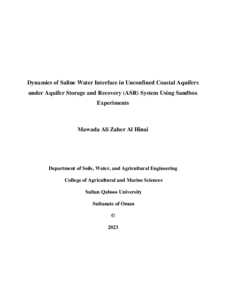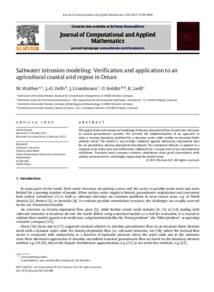Document
Dynamics of saline water interface in unconfined coastal aquifers under aquifer storage and recovery (ASR) system using sandbox experiments.
Source
Master's thesis
Country
Oman
City
Muscat
Publisher
Sultan Qaboos University
Gregorian
2023
Language
English
Thesis Type
Master's thesis
English abstract
Seawater intrusion (SWI) is a phenomenon that has raised various concerns in recent past years,
and it is described by the movement of saline water into freshwater coastal aquifers. The invasion
and movement of saline water induce a significant degradation to groundwater quality. The
majority of aquifers that are severely contaminated by SWI are unconfined coastal aquifers. In
order to manage saline aquifers more effectively, it is crucial to study the dynamics of groundwater
flow and contaminants transport. Consequently, remedial strategies/approaches need to be
conducted, developed, and planned with high efficiency. While several studies have investigated
various aspects of SWI using numerical models, physical sandbox experiments, field experiments
and investigations, or a combination of two or all, none have specifically explored the dynamics
of SWI under Aquifer Storage and Recovery (ASR) system using physical model (sandbox). ASR
systems are used as part of the aquifer management process, in order to mitigate the salinization
of groundwater reservoirs. Wells are used by ASR to inject freshwater into aquifers and to extract
it when needed. The main objective of this thesis project is to investigate how fresh-saline water
interface dynamics are affected by ASR systems using sandbox experiments with homogeneous
and heterogeneous (layered) coastal aquifer settings. This study provides knowledge and
understanding regarding the impact of ASR in managing unconfined coastal aquifers affected by
SWI. Sandbox models has the ability to visualize the changes in the fresh-saline water interface
directly along with allowing quantification of several parameters like saline water interface
position, salinized area of the aquifer, etc. A Poly (methyl methacrylate) (PMMA) sandbox
physical model used to mimic the unconfined homogenous and heterogeneous coastal aquifers
using artificial white sand. In homogeneous aquifer setting, three injection and abstraction wells
are installed in upstream (W1), midstream (W2) and downstream (W3). The heterogeneous (two
layers) has four injection/abstraction wells, each installed in a layer: upstream wells (W1, lower
layer & W1 upper layer) and midstream (W2, lower layer & W2 upper layer). Experiment analysis
consist of qualitative (images) and quantitative data measured in laboratory such as water level
and water salinity measurements. The primary finding of the study was that fresh water injection
contributes to management of saline aquifer via causing retreat of the saline interface seaward
direction.. This level of impact found to be a function of injection depth, injection to abstraction
period, storage period of injected water and other factors as detailed later in the results chapter.
Water injection near the saline interface toe was most effective scenario in reducing aquifer salinity
by 76% for the homogeneous aquifer. Two storage periods were set to store water after injection:
10 minutes and 20 minutes. The longer storage period (before start of abstraction/recovery)
resulted in higher reduction of saline area and salinity level. This is because injection helps to
increase water level and hence the hydraulic gradient that controls ingression of saline interface.
This illustrates the importance of identifying the specific storage period when ASR is practiced in
salinized coastal aquifers. Aquifer salinity increased during the water abstraction phase for all
abstraction scenarios (50%, 100%, 150%, and 200% of the injected volume) at both storage times
when injection was at W1 (upstream) and W3 (downstream). In contrary, water abstraction, when
injection into W2 (midstream) occurred, showed a reduction in aquifer salinity (compared to initial
condition scenario) for all runs in both storage durations, except for 150% and 200% abstractions
in 10-minute storage. In all runs in a homogeneous aquifer, the salinity of the water abstracted
was within the freshwater range when abstraction took place from W1 and W2, while the water
abstracted from W3 was saline water. The results of the heterogeneous aquifer were more realistic,
helping us to better understand fresh-saline water dynamics in various geological structures. The
W2 midstream injection was more effective in controlling aquifer salinity. Injection of fresh water
into the W2 lower layer decreased salinity by 53.3%, whereas injection into the W2 upper layer
decreased salinity by 55.8%. The aquifer remediation that involved injecting water into both
layers at W1 resulted in a 17.5% decrease in salinity. The 20-minute storage period selected as the
storage time to store injected water in heterogeneous aquifer setting. Water abstraction from
different wells from both layers showed an increase in aquifer salinity but with different levels.
The quality of water collected from all scenarios of the heterogeneous aquifer was within the
acceptable range of fresh water. The ideal ASR scenario for a heterogeneous aquifer is represented
by the case of injecting fresh water in the middle of the tank (W2) in the lower layer and abstracting
water from the upstream (W1) of the upper layer.
In general, the study illustrates clearly the impact of the ASR system in better sustaining the water
supply from the coastal aquifers. The results illustrated that ASR allows to abstract more
groundwater from the aquifer without jeopardizing the water quality compared with situation when
ASR not practiced. Better planning and optimum operation of ASR will help to sustain the aquifer
quality and hence the supply.
This study helps to better understand the potential dynamics of groundwater under the ASR system
in a layered system as it is the case in Al-Batinah North coastal aquifer where major abstraction is
from the more conductive upper layer. The findings of this study will help to validate developed
density-dependent numerical tools and represent a new benchmarking case study for those codes.
This is important due to the complicated flow patterns of density-dependent flow and transport in
a layered heterogeneous aquifer setting.
There is a need for future studies about fresh-saline water dynamics, such as implementing ASR
in confined aquifers, using the same well for injection and storage, and utilizing multiple wells for
abstraction. Numerical modeling to mimic the presented sandbox experiments need to be
conducted. This will allow to run more scenarios and analysis impact of different parameters on
the SWI dynamics.
Arabic abstract
تداخل مياه البحر مع المياه الجوفية الساحلية شكل تحديات مختلفة في العقود الاخيرة في العديد من الدول والمدن الساحلية ، وتتم من خالل دخول مياه البحار المالحة إلى طبقات المياه الجوفية العذبة التي تؤدي بدورها إلى تدهور جودة المياه الجوفية. غالبية أحواض المياه الجوفية الملوثة بسبب تسرب مياه البحر هي أحواض المياه الجوفية الساحلية الغير المحصورة. ولكي يتم ادارة الاحواض الجوفية المالحة بفعالية ، من الضروري دراسة حركة المياه الجوفية والامالح. العديد من الدراسات الميدانية والمخبريه ونماذج انظمة المحاكاة قد بحثت في جوانب مختلفة لتداخل مياه البحر بالاحواض الجوفية الساحلية ، ولم تستكشف أي منها على وجه التحديد ديناميكيات تسرب مياه البحر في تطبيق نظام تغذية وتخزين واستعاضة )إعادة سحب( مياة الخزان الجوفي. لذلك جائت هذا الدراسة لإستقصاء مدى تأثير نظام التغية الاصطناعية عن طريق الابار ومن ثم استعاضة المياه عن طريق تجارب مخبريه لخزانات الرمل التي تجسد الطبقات الجوفية. تُستخدم أنظمة تغذية وتخزين واستعادة الخزان الجوفي كجزء من عملية إدارة ومعالجة الخزان الجوفي من أجل معالجة وإدارة الخزانات الجوفية المتملحة. تستخدم الابار لتخزين المياه العذبة تحت الارض في طبقات المياه الجوفية واستخراجها عند الضرورة. تهدف هذه الاطروحة لدراسة كيفية تأثر ديناميكيات واجهة المياه العذبة والمالحة بأنظمة تغذية وتخزين واستعادة مياه الخزان الجوفي باستخدام تجارب خزان الرمل لدراسة التأثير على كل من الخزان الجوفي الساحلي المتجانس وغير المتجانس )ذو الطبقات(. تتيح هذه الدراسة المعرفة والفهم فيما يتعلق بدور نظام تغذية وتخزين واستعادة الخزان الجوفي في طبقات المياه الجوفية الساحلية غير المحصورة المتأثرة ب تداخل مياه البحر. حيث تسمح نماذج خزانات الرمل بالرؤية المباشرة لللتغييرات في حركة وديناميكية المياه المالحة مباشرةً وقياس العديد من المتغيرات بشكل دقيق ومباشر. تم استخدام خزان الرمل لتجسيد طبقات المياه الجوفية الساحلية غير المحصورة المتجانسة وغير المتجانسة باستخدام الرمال البيضاء الاصطناعية. عند إعداد الخزان الجوفي المتجانس، تم تثبيت ثالثة آبار للتغذية )الحقن( والاستعادة : في في جوانب ومنتصف الخزان ويتم استخدامها بشكل متبادل .بينما يحتوي الخزان الغير متجانس )طبقتان( على أربعة آبار للحقن / الاستعادة، كل منهما تم تثبيته إما في الطبقة السفلية أو الطبقة العلوية: بئرين في المنبع و بئرين في منتصف الخزان الرملي . يتم تحليل نتائج التجربة المخبرية من خالل البيانات الكيفية وتحليالتها )الصور( والكمية المقاسة في المختبر مثل قياسات منسوب المياه وملوحتها. أضهرت النتائج الرئيسية للدراسة أن حقن الماء العذب ساعد على تراجع المياة المالحة بإتجاه البحروالذي يسهم بدوره إلى خفض مستويات ونطاق الملوحة. حيث كان حقن الماء العذب بالقرب من طرف اللسان الملحي أكثر فعالية في خفض ومعالجة ملوحة الخزان الجوفي بنسبة تصل إلى ٪76 في الخزان الجوفي المتجانس. تم إعتماد فترتين لتخزين الماء بعد الحقن وقبل البدأ في الاستعاضة أثناء التجربة: 10 دقائق و 20 دقيقة. أظهرت نتائج فترة التخزين الاطول دخول )تغلغل( أقل للماء المالح في الخزان الجوفي. يعكس هذا أهمية تحديد وإختيار فترة تخزين المياه لمعالجة واستعادة صحة المياه الجوفية في أحواض المياه الجوفية الساحلية المعرضة للتلوث بالملوحة. أظهرت النتائج أن ملوحة الخزان الجوفي زادت أثناء مرحلة استعادة المياه لجميع نسب السحب )٪50 ٪200-( في كلتا فترات التخزين عندما يتم الحقن في المنبع و المصب .على العكس من ذلك ، أظهرت نتائج x انخفاضا بالحالة الاولية للخزان الجوفي المتملح( ً استعادة المياه عند الحقن في منتصف الخزان في ملوحة الخزان الجوفي )مقارنة لجميع التجارب في كلتا فترات التخزين ، باستثناء ٪150 و ٪200 من عمليات الاستعادة في فترة التخزين لمدة 10 دقائق. كذلك في جميع اتجارب الخزان الجوفي المتجانس ، كانت ملوحة المياه المستخرجة من الابار ضمن نطاق المياه العذبة عندما استخرجت )استعادة( من البئر الواقع في منتصف الخزان وأعلى الخزان الجوفي ، في حين أن المياه المستخرجة من البئر الواقعه بجانب مصدر المياه المالحه اكثر ملوحه. وقد ساهمت نتائج التجارب للخزان الجوفي الغير متجانس في فهم ديناميكة المياه المالحة.. كذلك كان الحقن في وسط الخزان أكثر تأثيرا في تقليل ملوحة الخزان الجوفي غير المتجانس. حقق حقن الماء العذب في منتصف الخزان في الطبقة السفلية إلى خفض الملوحة بنسبة ٪53 ، بينما أدى الحقن في الطبقة العلوية إلى خفض الملوحة بنسبة .٪56 أدت معالجة الخزان الجوفي التي تضمنت حقن الماء العذب في كلتا الطبقتين في جانب الخزان الرملي )اعلى الصندوق( إلى انخفاض بنسبة ٪17.5 في الملوحة. بناء على النتائج السابقه، تم اختيار فترة التخزين البالغة 20 دقيقة لتجارب الخزان الجوفي الغير متجانس. أظهرت عمليات استعادة المياه من كل الابار من كال الطبقتين زيادة في تداخل مياة البحر بالخزان الجوفي ولكن بمعدالت مختلفة. كانت جودة المياه التي تم جمعها من جميع تجارب الخزان الجوفي غير المتجانس ضمن نطاق المياه العذبة .كذلك أظهرت النتائج أن سيناريو تخزين واستعادة المياه الجوفية لطبقة المياه الجوفية غير المتجانسة عند حقن المياه العذبة في منتصف الخزان في الطبقة السفلية واستخراج المياه من الطبقة العلوية بأعلى الخزان تمثل المعالجة الافضل. بشكل عام، توضح هذه الدراسة تأثير نظام التغذية والتخزين والاستعادة للمياه في الحفاظ على إمدادات المياه بشكل أفضل من المياه أيضا أن تخزين المياه الجوفية واستخراجها يسمح بضخ المزيد من المياه الجوفية دون احاث ً الجوفية الساحلية، وأوضحت النتائج تدهور اكبر لجودة المياه. يساعد التخطيط الافضل والتشغيل الامثل لـنظام تخزين واستعادة المياة بالخزانات الجوفيه على الحفاظ على جودة المياه وبالتالي استدامة امداداتها. ساهمت هذه الدراسة في فهم ديناميكية المياه الجوفية تحت سيناريوهات الحقن والتخزين والاستعادة بشكل أفضل في الاحواض الجوفية متعددة الطبقات كما هو الحال في الخزان الجوفي الساحلي في شمال محافظات شمال وجنوب الباطنة حيث يتم السحب الرئيسي من الطبقة العليا الاكثر نفاذية . كذلك تساعد نتائج هذه الدراسة في التحقق من صحة النماذج العددية لمحاكات حركة المياه الجوفية حيث تكمن أهميتها في فهم تعقيدات أنماط حركة الما والامالح )الملوثات( المتأثر بكثافة الماء في طبقات المياه الجوفية غير المتجانسة. هناك حاجة لدراسات مستقبلية لفهم المزيد عن حركة المياه والامالح مثل: تنفيذ نظام تخزين واستعادة الخزان الجوفي في طبقات المياه الجوفية المحصورة ، استخدام نفس البئر للحقن والاستعادة ، واستخدام آبار متعددة لسحب المياه. كما ان هناك حاجة للقيام بدراسة تفصيليه باسخدام النماذج العددية والتي تسمح لدراسة انماط وعوامل وتغيرات عديدة لحركة الماة والاملاح بالخزانات الجوفيةالساحلية كون النماذج العددية اكثر مرونة وسهوله في التنفي مقارنه بخزانات الرمل.
Category
Theses and Dissertations


